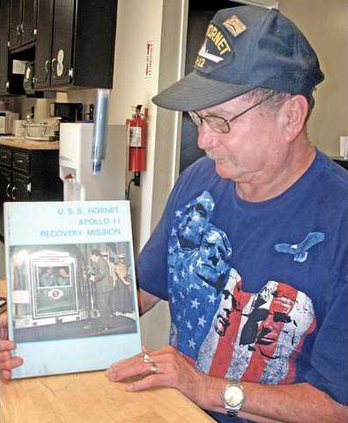July 24, 1969 is a date that Robert Serpa has long remembered.
He was a seaman aboard the U.S.S. Hornet and a few days shy of his 28th birthday.
Serpa worked in the engine room of the famed aircraft carrier selected by the U.S. Navy as the Prime Recovery Ship for Apollo 11 otherwise known as America’s first lunar landing.
“We never saw footage of the moon landing because we were out practicing (in the Pacific Ocean) on recovery of the space capsule,” he recalled last Friday.
A few days earlier, the Eagle with the two-man crew of astronauts Neil Armstrong and Edwin “Buzz” Aldrin had fulfilled President John F. Kennedy’s decade-long challenge of sending a man to the moon and returning him home safely.
“We had no idea where (the command module, Columbia) was going to splash down. We only knew it was important for us to keep a safe distance,” Serpa said.
Columbia with Armstrong, Aldrin and Michael Collins returned safely to Earth about a mile or so away from the Hornet.
“I could remember looking up and seeing a streak in the sky followed by a sonic boom. (Columbia) went twice around the Earth before splashing down. We saw the parachutes open (for the space capsule) and then applauded,” said Serpa.
He thought back to his grammar school days when he heard the naysayers utter, “Man will never walk on the moon.”
Serpa, who grew up in Phoenix, thought otherwise. He had a fascination with space travel thanks to science fiction characters such as Buck Rogers. Serpa also recalled going to the Saturday movies and catching footage of the U.S. space program in its infancy. “They had a man on a rocket sled to test the G-force,” he said.
The Navy gave him a chance of a lifetime to not only travel halfway around the world but become a part of history. The Hornet was Serpa’s home from 1968 through 1970.
The Apollo 11 crew was retrieved via helicopter to the aircraft carrier. Armstrong, Aldrin and Collins stepped aboard the Hornet wearing protective suit to safeguard against possible space diseases. Serpa stood near the edge of the flight deck when the astronauts made their way to the self-contained 11-by-14-foot Silver Module better known as the “Hornet +3.”
The aircraft carrier was accustomed to accommodating 5,000. But on this day, the Hornet was also carrying a large contingent of media and dignitaries.
“We almost ran out of water,” Serpa said.
For 30 days, Apollo 11 crew was kept in quarantine. The “Hornet +3” also had physicians inside with astronauts to run a battery of tests.
But before that, they received congratulations from a very special guest.
“No knew that Nixon was coming aboard. It was just a rumor,” said Serpa.
President Richard M. Nixon was greeted on the aircraft carrier with the playing of “Hail to the Chief.” He was there to personally meet with Armstrong, Aldrin and Collins, who were peering through the hatch of the Silver Module for the famous photograph with their Commander in Chief.
“At that moment, I remembered being very proud,” said Serpa, who marked this momentous occasion with a letter of recognition from President Nixon.
The Hornet also retrieved the crew of Apollo 12 and was scheduled for Apollo 13.
“We were looking forward to (Apollo 13) since that meant going to the Indian Ocean and staying in Australia. But then it was ‘Houston, we have a problem…,’” Serpa said.
Apollo 11 was near and dear to him. Serpa purchased a keepsake book of that historic event: “U.S.S. Hornet: Apollo 11 Recovery Mission.”
He lived in Hayward for years and was employed by Fremont Unified.
Robert Serpa and his wife, Marlene, have been married for 43 years. They’ve been in Manteca for 12 years.
Serpa volunteers his time at the Manteca Senior Center. He’s involved in the senior advisory group.
Meanwhile, his family has expanded to a dozen grandchildren.
Serpa has visited the Hornet, now a floating museum docked in Alameda, on numerous occasions, including a few times with his grandchildren.
“They’re always saying, ‘that’s grandpa’s ship,’” he said.
Serpa is saddened by the state of the NASA program – he recently kept tabs on the final space shuttle mission – but is hopeful of the U.S. resuming space travel.
“If you ask me, I thought they should have continued going to the moon,” Serpa said.
On hand for historic splashdown



